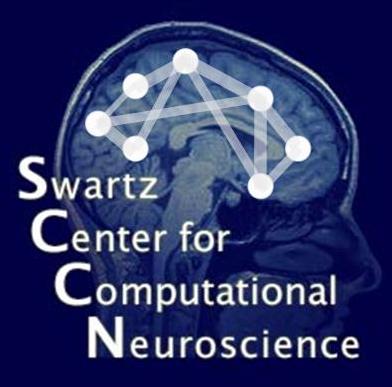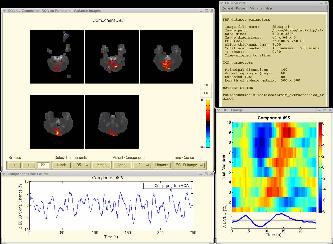
SCCN Home
EEGLAB Home
the home page of
FMRLAB
FMRLAB News!!
The newest version of FMRLAB, FMRLAB v4.0, is ready for download. Please download. New tutorial will be available soon with instructions to all new features. Any questions and bugs, please report to fmrlab@sccn.ucsd.edu or duann@sccn.ucsd.edu.
FMRLAB Release Note
read release note of FMRLAB v4.0.
What is FMRLAB?
 FMRLAB is a Matlab toolbox for fMRI data analysis using Independent
Component Analysis (ICA). It provides an integrated environment to
manage, process and analyze fMRI data in a single framework so that
users can complete the analysis without switching between software. In
addition, it provides an interactive Matlab graphic user interface
(GUI). All the necessry processes to apply ICA to fMRI data and review its
results can be run from the graphic interface.
The FMRLAB processing flow is straightforward. Custom analyses can
be performed with Matlab scripts using the FMRLAB functions
and data structure.
FMRLAB is a Matlab toolbox for fMRI data analysis using Independent
Component Analysis (ICA). It provides an integrated environment to
manage, process and analyze fMRI data in a single framework so that
users can complete the analysis without switching between software. In
addition, it provides an interactive Matlab graphic user interface
(GUI). All the necessry processes to apply ICA to fMRI data and review its
results can be run from the graphic interface.
The FMRLAB processing flow is straightforward. Custom analyses can
be performed with Matlab scripts using the FMRLAB functions
and data structure.
Why FMRLAB?
Since fMRI data analysis is a complex enterprise, including digital image processing, statistical analysis and data visualization, an integrated framework combining processing elements is desired eagerly by users in the neuroimaging community. Recently, large number of software tools for data analysis and visualization have been developed for this purpose. However, most of these tools use model-based statistical methods which assume that the users know the hemodynamic response (HR) for their paradigm in advance and can specify a reasonable HR model. Often, however, accurate or reasonable response HR models are unavailable. An alternative data-driven method, infomax ICA (McKeown et al., 1998), does not require that an a priori HR model, instead deriving HRs of spatially indendent components of the entire data set from the higher-order statistics of the data themselves.
FMRLAB is a toolbox running under Matlab containing necessary components for data-driven fMRI data analysis using the highly reliable infomax ICA algorithm (Bell & Sejnowski, 1995), normalized (Amari, 1999), extended (Lee, Girolami and Sejnowski, 1999) and automated by Makeig et al. FMRLAB has been developed under Matlab 6.1 running on Red Hat Linux.
Caution: FMRLAB is a toolbox written and released for neuroimaging research purposes only. FMRLAB, or data obtained from FMRLAB, should not under any circustances be used for clinical purposes.
FMRLAB Features
- Graphic user interface
- Flexible data importing
- Interactive data plotting
- Computationally efficient
- Defined FMRI data structure
- Independent component browser
- Smooth, transparent component exporting and spatial normalization process
- Interface with other software for further analysis or visualization.
- SPM-style component plots (MIP, 2-D slice overlay and 3-D)
FMRLAB Developers
Jeng-Ren Duann with Scott Makeig and Tzyy-Ping Jung, plus important contributions from Martin J. McKeown, Sigurd Enghoff, Te-Won Lee, Tony Bell and others. Special thanks goes to Arnaud Delorme for his contributed functions and great help to make this web site complete. FMRLAB and its predecessor, the EEG/ICA tolbox, were first developed at the Computational Neurobiology Lab of The Salk Institute for Biological studies. Its development is now centered at the Swartz Center for Computational Neuroscience of the Institute for Neural Computation of the University of California San Diego. Early development of FMRLAB was supported by NIH Grant: Independent Component Analysis of Human Brain Activity (5RO1MHO61619-03, PI Prof. Terrence J. Sejnowski).
Future Development
FMRLAB is under active open-source development. In the
near future, we plan to extend its capabilities to:
Links
Feedback
